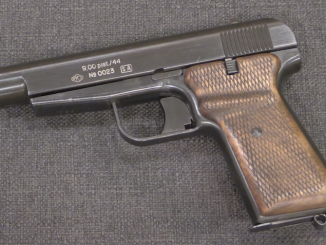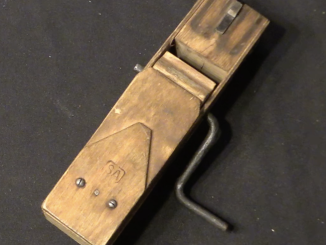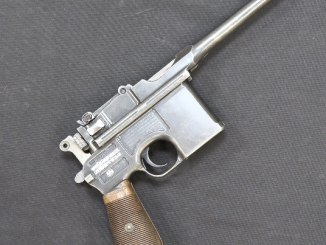Michael Heidler’s bi-lingual (German and English) book on the Finnish Suomi m/31 submachine gun is a small but dense history of one of the best submachine guns of World War Two. It covers Aimo Lahti’s background, the development of the submachine gun, its adoption by the Finnish Defense Forces, the handful of variations made, and its training and use in the Winter War and Continuation War. Because of Finnish tactics and the densely forested environments of the combat, the Suomi became perhaps the most important Finnish weapon in their wars against Russia. Light machine guns were too heavy, and their benefits could not be properly exploited by the Finnish fast-moving and close-in style of combat, but the Suomi excelled.
The book is just under 100 pages long, with about 60 of those consisting of a wealth of excellent photos from the SA Kuva military archive. All of the text and photo captions are presented side by side in both English and German. The book may not be large, but it is well presented and an excellent reference on an otherwise rather obscure weapon. Pricing at the time of this filming is 29 Euro shipped in Germany, 34 Euro shipped to the rest of the EU, and $44 US shipped outside of the EU. Available direct from the author via PayPal. Email him at GGBuch@web.de to order a copy.




Read his article about stens for the volkssturm, if this book is even half as good, then it is definitely wort that money.
An excellent book, indeed! Well worth the cost, and it would be an easy sell at twice the price. For Finnish-focused collection of the M/31 and accessories, it’s a must-have.
“book”
Does it also covers export sales of SUOMI sub-machine gun?
“Light machine guns were too heavy, and their benefits could not be properly exploited by the Finnish fast-moving and close-in style of combat, but the Suomi excelled.”
Default Finnish light-machine gun of that era – Lahti-Saloranta M/26:
http://www.jaegerplatoon.net/LMG1.htm
was not especially slick, showing some reliability problems in actual usage, partially due to lacks in maintenance, but not only. Ergonomics was also somewhat lacking, magazine has been to loaded with special device, if you want to full capacity (20) which BTW was rather on lower end of scale for 1920s light-machine guns.
Continuing:
so it is not wonder than Finnish soldier, who fought during Talvisota might have more fondly memories about sub-machine gun than light machine gun.
Interestingly SUOMI sub-machine gun seems to follow to some degree thinking “sub-machine gun should be diminutive light machine gun”, as evidenced by bi-pod. This thinking was present in inter-war period in other countries too (see for example Czechoslovak ZK-383), but in real combat it proved to not work well.
The KP/31 was probably, all things considered, the best submachine gun on the market during the inter-war period; very well-made, reliable, and user-friendly. Even the British Army, who notoriously held the opinion that submachine guns were a novelty, conceded that the Suomi was an excellent gun when they tested it in ’36, and again in ’38. It is often said that it influenced the design of the Soviet PPD, and later the PPSh.
What it wasn’t, however, was cheap. It is perhaps ironic that the gun that inspired Soviet designers was itself replaced by a Soviet gun – the PPS, which was copied by the Finns as the M/44.
“KP/31 was probably, all things considered, the best submachine gun on the market during the inter-war period”
Best is, as always, arguable, but anyway Oy Tikkakoski Ab should be praised for ability to deliver such good weapon without having prior experience with production of machine guns.
From the Record of Developmental and Experimental Ordnance Vol. 17, The Sub-Machine Gun (Wash. D.C.: Office of the Chief of Ordnance, Research and Development Service, n.d.), IF14:
“SUOMI–The Suomi 9 mm submachine gun (Fig. 9), a Finnish development, was tested at Aberdeen on 18, 19, 22, 26 July and 2 August 1940. It is a straight blowback operated weapon with a selector permitting semi0automatic and full-automatic fire. The 25-round magazine is inserted from below.
Five hundred thirty-nine rounds were fired to test general functioning and to compare the performance of the Suomi with that of the Thompson M1928A1. Those who fired the Suomi commented favorably on its performance. The Finnish weapon appeared to handle better in semi-automatic fire but was inferior to the Thompson in full-automatic. The recoil of the Suomi was less than that of the Thompson, due to the lighter cartridge, but the tendency to climb was greater. There is no muzzle brake or compensator.
The timed cyclic rate of the gun was 833 rounds per minute. The bolt does not remain open after the last round is fired.
ACCURACY–The Suomi was fired for accuracy at a range of 1,000 inches (83′ 4″) from a machine rest with the following results:
Rounds 5 Type of Fire Semi-auto. 0.99″ EHD 1.18″ EVD 1.38″ ES
Rounds 5 Type of Fire Semi-auto. 0.49″ EHD 0.98″ EVD 1.00″ ES
Rounds 10 Type of Fire Automatic. 1.05″ EHD 1.32″ EVD 1.50″ ES
Rounds 10 Type of Fire Automatic. 0.34″ EHD 1.13″ EVD 1.22″ ES
Rounds 10 Type of Fire Automatic. 1.11″ EHD 1.68″ EVD 1.60″ ES
Data on the Thompson M1928A1, at the same range reports the following:
Rounds 10 Type of Fire Semi-auto. 2.73″ EHD (avg.) 1.55″ EVD 3.04″ ES
Rounds 20 Type of Fire Automatic. 2.87″ EHD (avg.) 5.17″ EVD 5.47″ ES
In making comparisons it must be remembered that the targets were fired with ammunition of different caliber, charge, and weight.
The Suomi was also fired for accuracy at 300 yards, machine rest:
10 Rounds … 11.10″ EHD 13.55″ EVD 16.10″ ES
10 rounds … 8.50″ EHD 19.70″ EVD 19.85″ ES
10 rounds … 11.05″ EHD 18.50″ EVD 18.55″ ES
No comparison was made with the Thompson at that range.
DUST TEST–The Suomi functioned normally after being subjected to the standard dust test. The thompson failed to fire four of ten rounds, malfunctions being due to weak blows on the primer.
MUD TEST–Neither gun functioned after immersion in thin mud. The bolt of the Thompson would not move; the Suomi bolt moved forward slowly but with sufficent force to remove a cartridge from the magazine.
Direct comparison between the Suomi and the Thompson M1828A1 was difficult [?] because of the difference of calibers. The Suomi is simpler in design and may be disassembled more easily. It is slightly more effective than the Thompson under adverse conditions of dust and mud. The recoil is less because of the lighter cartridge.
The Suomi is heavier than the Thompson by .7 pound, it has a greater tendency to climb in automatic fire, and the fire control and safety latch are poorly designed [?].
Due to the gun’s use of ammunition not standard in the U.S. Army, the Suomi was not recommended for service tests.”
Great book. Small but full of info.
I still have some copies of this book available in the US. $50, includes US postage.
John@GermanManuals.com